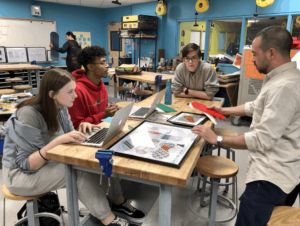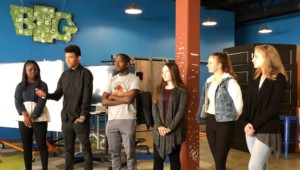My Big Adventure with BYOD

I’m not exactly a newcomer to BYOD (bring your own device) teaching. And I’m no stranger to sneaking it in under the radar either. At the moment, I’m testing various devices with my fifth and sixth-graders, with the blessing of my students’ parents, my technology support team, and my administration. I’ve learned a few things in the process.
First Attempts: BYOD with Cell Phones
Ages ago, it seems, before the term BYOD even existed, I taught at a school that still forbade students to carry their cell phones with them to class (they later changed their minds on this hopelessly unenforceable rule). One day I enjoyed pausing dramatically at the beginning of a lesson and calmly announcing, “Please take out your cell phones.”
The students glanced at one another guiltily. They knew they were not allowed to carry cell phones with them, but most of them did it anyway. Was this a trick?
“C’mon, take them out and put them on your desk,” I urged them, and slowly, one by one, almost every single student reached into his or her backpack and plucked out a phone. Looking me straight in the eye, their faces emitted the universal language of “Am I in trouble?”
“Now,” I said, we will begin our lesson on podcasting.” And the students proceeded to use a Mad Libs style script to fill in the blanks with interpretation and analysis of vocabulary words in Shakespeare’s Othello. They then called a phone number I provided for them, read the script, and produced a downloadable podcast for other students to use. Doing something they might consider tedious in any other venue, they were overjoyed to learn in this new and entirely comfortable way.
At the time I used the now defunct Gabcast. But I’ve recently discovered Vocaroo, which works similarly. Certainly, you could create equivalent results with any number of screen-casting or digital storytelling applications out there. In fact, the digital storytelling apps I’ve been using recently would be perfect for this. (I will review the various applications we’ve used in my next post.)
Recent Attempts: BYOD Digital Storytelling
My current school has implemented a pilot iPad program with our eighth grade. Throughout the year, my younger students have asked, “Why can’t I bring my iPad to school?” It seems that many of my students receive older iPads or iPhones as cast-offs from their parents or older siblings. Even those who do not possess these “toys” tend to own an iPod Touch or a Kindle Fire. They use their devices to play games in the car or to pass the time at home in-between violin lessons and soccer practice. Why shouldn’t they bring them to school and learn to see their devices as resources for learning, indeed?
So, as I dove into a digital storytelling project with my current fifth-graders, I allowed my students to bring in devices from home with their parents’ permission. We locked the devices in a classroom cabinet to keep them safe and to avoid the temptation of distraction throughout the day. (The last thing I wanted was to have an expensive device stolen or to have a student get in trouble for misusing a device in another class. If parents would be upset at the former, my teacher colleagues would grumble about the latter – and I needed support from both.)
My students had written and revised their stories, created scripts and storyboards, and selected or created images before using their devices and choosing apps. They figured out how to research copyright-free or Creative Commons photos, upload their images (probably our most cumbersome process), and record voice-overs. Not surprisingly, the trickiest part was figuring out how to transfer the various completed media from the students’ device to my computer, so that I could begin the process of “publishing” their stories on TeacherTube and a class wiki for our community to enjoy.
Students ultimately chose from the following applications: Educreations, ScreenChomp, StoryKit, StoryRobe, Photo Story 3, Animoto, and VoiceThread.
Meanwhile, despite our digital storytelling project being over and done with weeks ago, my students beg to watch a least a couple of their peers’ stories in class each day. How empowering of student writers is that? Now, even those students who did not quite pull everything together for their stories, or those who needed to edit their overly ambitious work for uploading and sharing purposes, are revising and editing their stories because they want them to be seen. Authentic learning? You betcha.
Our experiment was by no means stress or error-free; however, it was mostly successful. As I repeat my BYOD experiment with my upcoming sixth-grade “book talks,” I can take into account the many lessons we – parents, tech team, and students — all learned together.





0 Comments
Leave a Comment
Your email address will not be published. All fields are required.